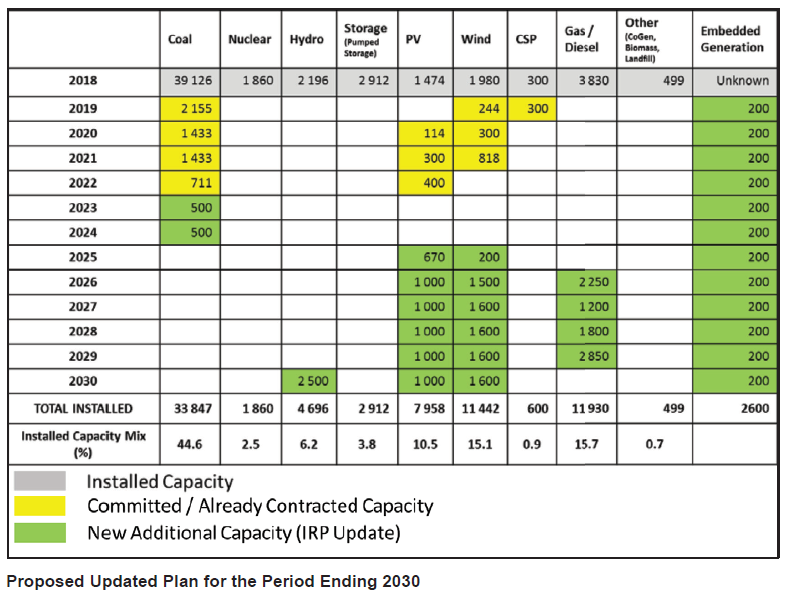


Electricity Regulation Act, 2006 (Act No. 4 of 2006)NoticesIntegrated Resource Plan 20196. Appendices6.4 Appendix D : Summary of Published Draft IRP 20186.4.4 Draft IRP 2018 |
Drawing from the conclusions of the scenarios analysed, the scenario of RE without annual build limits provides the least-cost path up to 2050. The significant change in the energy mix post 2030 and the sensitivity of the energy mix to the assumptions are key points to note.
It was therefore recommended that the post 2030 path not be confirmed, but that detailed studies be undertaken to inform the future update of the IRP. These studies should, among others, include the following:
| • | Detailed analysis of gas supply options (international and local) to better understand the technical and financial risks and required mitigations for an RE and gas dominated electricity generation mix post 2030. |
| • | Detailed analysis of the appropriate level of penetration of RE in the South African national grid to better understand the technical risks and mitigations required to ensure security of supply is maintained during the transition to a low-carbon future. Some work has been done on the impact of increasing shares of variable generation on system operations in South Africa (Flexibility Study). There is a need to expand this work to include an in-depth analysis of technical options such as reduced inertia, reduced synchronizing torque, reduced voltage support and reduced contribution to short-circuit currents to overcome stability issues resulting from non-synchronous generation and distributed generation. There is also a need to determine whether the stability issues will become relevant in the near, mid and long term. The above-mentioned technical options are most suitable to overcome the challenge. This part of work is already under consideration. |
| • | Detailed analysis of other clean energy supply options (coal, hydro, nuclear and others), including their associated costs and economic benefits. The NDP Update acknowledges the potential to increase the efficiency of coal conversion and calls for any new coal-power investments to incorporate the latest technology. The NDP Update calls for cleaner coal technologies to be supported through research and development, and technology transfer agreements in ultra-supercritical coal power plants; fluidised-bed combustion; underground coal gasification; integrated gasification combined cycle plants; and carbon capture and storage, among others. The NDP Update further acknowledges the role of nuclear in the energy mix and calls for a thorough investigation of the implications of nuclear energy, including its costs; financing options; institutional arrangements; safety; environmental costs and benefits; localisation and employment opportunities; and uranium-enrichment and fuel-fabrication possibilities. |
Such an analysis would therefore be in line with and in support of commitments in the NDP Update.
| • | Detailed socio-economic impact analysis of the communities impacted by the decommissioning of old, coal-fired power plants that would have reached their end-of-life. Such an analysis would go a long way in ensuring that communities built on the back of the coal-to-power sector are not left behind during the transition. |
For the period ending 2030, a number of policy adjustments is proposed to ensure a practical plan that will be flexible to accommodate new, innovative technologies that are not currently cost competitive, the minimization of the impact of decommissioning of coal power plants and the changing demand profile.
Recommended policy adjustment is as follows:
| • | Adopt a least-cost plan with the retention of annual build limits (1000MW for PV and 1600MW for wind) for the period up to 2030. This provides for smooth roll out of RE, which will help sustain the industry. |
| • | Make provision for 1000MW of coal-to-power in 2023–2024, based on two already procured projects. Jobs created from the projects will go a long way towards minimizing the impact of job losses resulting from the decommissioning of Eskom coal power plants and will ensure continued utilisation of skills developed for the Medupi and Kusile projects. |
| • | Make provision for 2500MW of hydro power in 2030 to facilitate the RSA-DRC treaty on the Inga Hydro Power Project in line with South Africa’s commitments contained in the NDP Update to partner with regional neighbours, The Project |
| • | has the potential to unlock regional industrialisation. |
| • | Adopt a position that all new technologies identified and endorsed for localisation and promotion will be enabled through Ministerial Determinations utilising existing allocations in the IRP Update. This approach is supported by existing electricity regulations. The Electricity Regulations on New Generation Capacity enables the Minister of Energy to undertake or commission feasibility studies in respect of new generation capacity taking into account new generation capacity as provided for in the IRP Update. Such feasibility studies are, among others, expected to consider the cost of new capacity, risks (technical, financial and operational) and value for money (economic benefits). |
| • | Adopt a position that makes annual allocations of 200MW for new generation for-own-use between 1MW to 10MW, starting in 2018. These allocations will not be discounted off the capacity allocations in the IRP Update initially, but will be discounted during the issuing of determinations taking into account generation for own use filed with NERSA. |
The recommended updated Plan is as depicted in the table below. Impact on price path is discussed later.

| • | Coal Installed Capacity is less the 12 000 MW capacity to be decommissioned between years 2020 and 2030 |
| • | Existing and committed Coal, Nuclear, Hydro and Pumped Storage Capacity is less auxiliary power. Stated numbers are therefore based on sent out capacity not rated capacity. |
| • | Two additional units at Medupi have since been commissioned which is earlier than previously assumed. |
| • | Distributed generation for own use installed base is unknown as these installations were exempted from holding a generation license or were not required to be registered. |